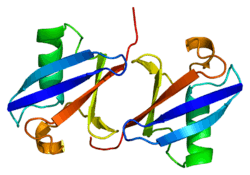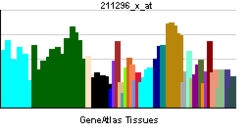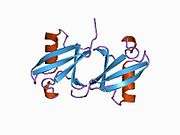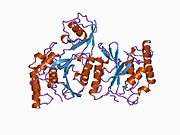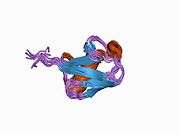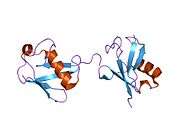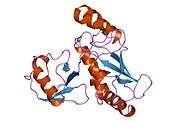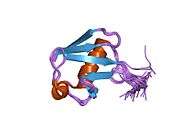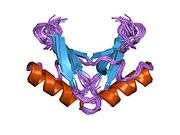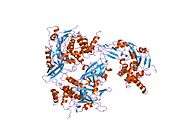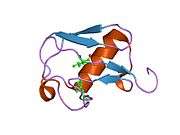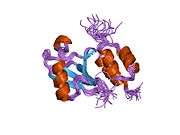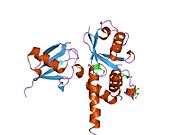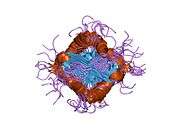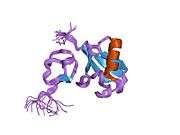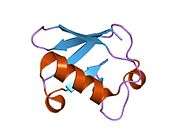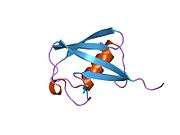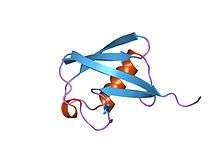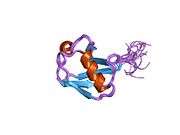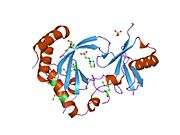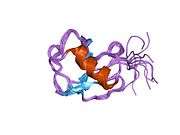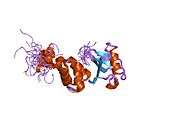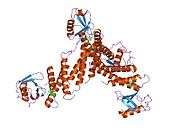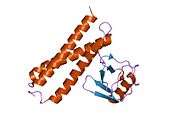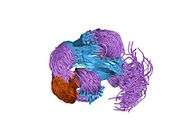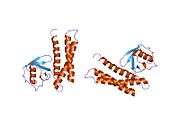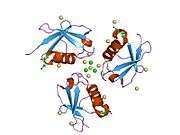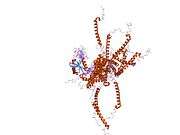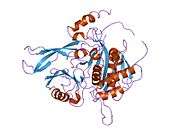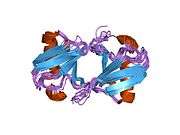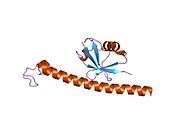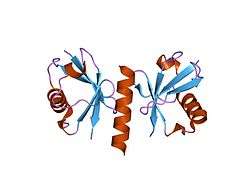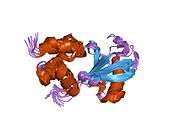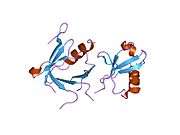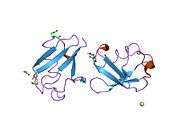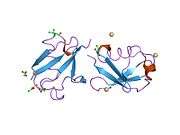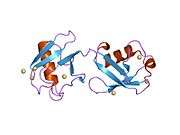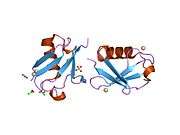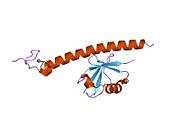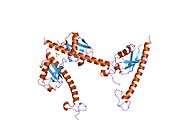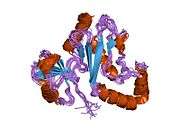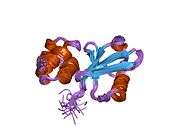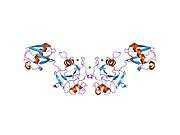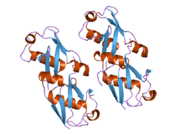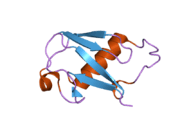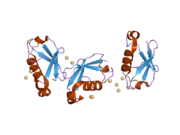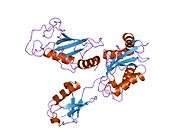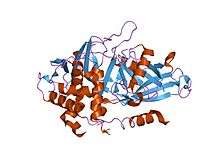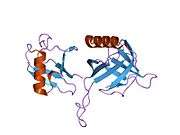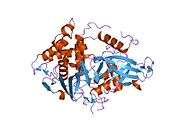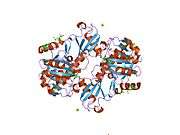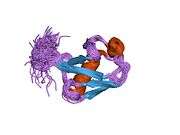Ubiquitin C
| View/Edit Human | View/Edit Mouse |
Polyubiquitin-C is a protein encoded by the UBC gene in humans.[3][4][5] Polyubiquitin-C is one of the sources of ubiquitin, along with UBB, UBA52, and RPS27A.[6] UBC gene is one of the two stress-regulated polyubiquitin genes (UBU and UBC) in mammals. It plays a key role in maintaining cellular ubiquitin levels under stress conditions.[7][8] Defects of UBC gene could lead to mid-gestation embryonic lethality.
Structure
Gene
UBC gene is located at chromosome 12q24.3, consisting of 2 exons. The promoter of the UBC gene contains putative heat shock elements (HSEs), which mediates UBC induction upon stress. UBC gene differs from UBB gene in the number of Ub coding units they contain. [7] Nine to ten Ub units were in the UBC gene.
Protein
In polyubiquitin-C, the C-terminus of a given ubiquitin molecule is covalently conjugated to either the N-terminal residue or one of seven lysine residues of another ubiquitin molecule.[9] Different linking of ubiquitin chains results in distinct conformations. There are 8 linkage types of polyubiquitin-C, and each type possesses the linkage-dependent dynamics and a linkage-specific conformation. [10][11]
Function
The diversity of polyubiquitin-C means that ubiquitylation contributes to the regulation of many cellular events. Polyubiquitin-C doesn’t activate the heat-shock response, but it plays a key role in sustaining the response. UBC gene transcription is induced during stress and provides extra ubiquitin necessary to remove damaged/unfolded proteins.[8][12] Polyubiquitin-C has important role in diverse biological processes, such as innate immunity, DNA repair and kinase activity.[13][14][15] Unanchored polyubiquitin-C are also key signaling molecules that connect and coordinate the proteasome and autophagy to eliminate toxic protein aggregates.[16]
Clinical significance
Loss of a single UBC allele has no apparent phenotype, while homozygous deletion of UBC gene leads to mid-gestation embryonic lethality due to a defect in fetal liver development, as well as a delay in cell-cycle progression and increased susceptibility to cellular stress.[8] It is also reported that homozygous deletion of UBC gene in mouse embryonic fibroblasts will cause decreased cellular Ub level and reduced viability under oxidative stress.[17]
Interactions
Polyubiquitin-C has been shown to interact with:
- BIRC2,[18][19][20]
- BSG,[21]
- C21orf59,[22]
- CDC2,[23]
- E2F1,[24]
- EGFR,[25][26][27]
- HDAC3,[23]
- HIF1A,[28][29][30]
- IRAK1,[31][32][33][34]
- KIAA0753.[35]
- MARK4,[36]
- MDM2,[37][38][39]
- NDUFA3,[40]
- NFE2L2,[41][42]
- NOTCH1,[43]
- NUAK1,[36]
- OPRK1,[44]
- P53,[25][37][38][39][45][46][47][48]
- PCNA[49][50][51]
- PARK2,[52][53]
- RIPK1,[18][31][54][55][56]
- RPS6KB1,[57]
- S100A10,[58]
- SCNN1A,[59][60]
- SCNN1G,[59][60]
- SFPQ,[61]
- SMAD3,[62][63]
- SMURF2,[64][65]
- SP1,[66]
- TRAF6,[31][32][54][67][68] and
- THRA.[23]
References
- ↑ "Human PubMed Reference:".
- ↑ "Mouse PubMed Reference:".
- ↑ Board PG, Coggan M, Baker RT, Vuust J, Webb GC (April 1992). "Localization of the human UBC polyubiquitin gene to chromosome band 12q24.3". Genomics. 12 (4): 639–42. doi:10.1016/0888-7543(92)90287-3. PMID 1315303.
- ↑ Marinovic AC, Zheng B, Mitch WE, Price SR (May 2002). "Ubiquitin (UbC) expression in muscle cells is increased by glucocorticoids through a mechanism involving Sp1 and MEK1". The Journal of Biological Chemistry. 277 (19): 16673–81. doi:10.1074/jbc.M200501200. PMID 11872750.
- ↑ "Entrez Gene: UBC ubiquitin C".
- ↑ Kimura Y, Tanaka K (June 2010). "Regulatory mechanisms involved in the control of ubiquitin homeostasis". Journal of Biochemistry. 147 (6): 793–8. doi:10.1093/jb/mvq044. PMID 20418328.
- 1 2 Wiborg O, Pedersen MS, Wind A, Berglund LE, Marcker KA, Vuust J (March 1985). "The human ubiquitin multigene family: some genes contain multiple directly repeated ubiquitin coding sequences". The EMBO Journal. 4 (3): 755–9. PMID 2988935.
- 1 2 3 Ryu KY, Maehr R, Gilchrist CA, Long MA, Bouley DM, Mueller B, Ploegh HL, Kopito RR (June 2007). "The mouse polyubiquitin gene UbC is essential for fetal liver development, cell-cycle progression and stress tolerance". The EMBO Journal. 26 (11): 2693–706. doi:10.1038/sj.emboj.7601722. PMID 17491588.
- ↑ Komander D, Rape M (2012). "The ubiquitin code". Annual Review of Biochemistry. 81: 203–29. doi:10.1146/annurev-biochem-060310-170328. PMID 22524316.
- ↑ Ye Y, Blaser G, Horrocks MH, Ruedas-Rama MJ, Ibrahim S, Zhukov AA, Orte A, Klenerman D, Jackson SE, Komander D (December 2012). "Ubiquitin chain conformation regulates recognition and activity of interacting proteins". Nature. 492 (7428): 266–70. doi:10.1038/nature11722. PMID 23201676.
- ↑ Castañeda CA, Kashyap TR, Nakasone MA, Krueger S, Fushman D (July 2013). "Unique structural, dynamical, and functional properties of k11-linked polyubiquitin chains". Structure. 21 (7): 1168–81. doi:10.1016/j.str.2013.04.029. PMID 23823328.
- ↑ Tsirigotis M, Zhang M, Chiu RK, Wouters BG, Gray DA (December 2001). "Sensitivity of mammalian cells expressing mutant ubiquitin to protein-damaging agents". The Journal of Biological Chemistry. 276 (49): 46073–8. doi:10.1074/jbc.M109023200. PMID 11598140.
- ↑ Rajsbaum R, Versteeg GA, Schmid S, Maestre AM, Belicha-Villanueva A, Martínez-Romero C, Patel JR, Morrison J, Pisanelli G, Miorin L, Laurent-Rolle M, Moulton HM, Stein DA, Fernandez-Sesma A, tenOever BR, García-Sastre A (June 2014). "Unanchored K48-linked polyubiquitin synthesized by the E3-ubiquitin ligase TRIM6 stimulates the interferon-IKKε kinase-mediated antiviral response". Immunity. 40 (6): 880–95. doi:10.1016/j.immuni.2014.04.018. PMID 24882218.
- ↑ Rajsbaum R, García-Sastre A (October 2014). "Virology. Unanchored ubiquitin in virus uncoating". Science. 346 (6208): 427–8. doi:10.1126/science.1261509. PMID 25342790.
- ↑ Pickart CM, Fushman D (December 2004). "Polyubiquitin chains: polymeric protein signals". Current Opinion in Chemical Biology. 8 (6): 610–6. doi:10.1016/j.cbpa.2004.09.009. PMID 15556404.
- ↑ Hao R, Nanduri P, Rao Y, Panichelli RS, Ito A, Yoshida M, Yao TP (September 2013). "Proteasomes activate aggresome disassembly and clearance by producing unanchored ubiquitin chains". Molecular Cell. 51 (6): 819–28. doi:10.1016/j.molcel.2013.08.016. PMID 24035499.
- ↑ Ryu HW, Ryu KY (January 2011). "Quantification of oxidative stress in live mouse embryonic fibroblasts by monitoring the responses of polyubiquitin genes". Biochemical and Biophysical Research Communications. 404 (1): 470–5. doi:10.1016/j.bbrc.2010.12.004. PMID 21144824.
- 1 2 Bertrand MJ, Milutinovic S, Dickson KM, Ho WC, Boudreault A, Durkin J, Gillard JW, Jaquith JB, Morris SJ, Barker PA (June 2008). "cIAP1 and cIAP2 facilitate cancer cell survival by functioning as E3 ligases that promote RIP1 ubiquitination". Molecular Cell. 30 (6): 689–700. doi:10.1016/j.molcel.2008.05.014. PMID 18570872.
- ↑ Didelot C, Lanneau D, Brunet M, Bouchot A, Cartier J, Jacquel A, Ducoroy P, Cathelin S, Decologne N, Chiosis G, Dubrez-Daloz L, Solary E, Garrido C (May 2008). "Interaction of heat-shock protein 90 beta isoform (HSP90 beta) with cellular inhibitor of apoptosis 1 (c-IAP1) is required for cell differentiation". Cell Death and Differentiation. 15 (5): 859–66. doi:10.1038/cdd.2008.5. PMID 18239673.
- ↑ Sekine K, Takubo K, Kikuchi R, Nishimoto M, Kitagawa M, Abe F, Nishikawa K, Tsuruo T, Naito M (April 2008). "Small molecules destabilize cIAP1 by activating auto-ubiquitylation". The Journal of Biological Chemistry. 283 (14): 8961–8. doi:10.1074/jbc.M709525200. PMID 18230607.
- ↑ Wang WJ, Li QQ, Xu JD, Cao XX, Li HX, Tang F, Chen Q, Yang JM, Xu ZD, Liu XP. "Interaction between CD147 and P-glycoprotein and their regulation by ubiquitination in breast cancer cells". Chemotherapy. 54 (4): 291–301. doi:10.1159/000151225. PMID 18689982.
- ↑ Kim W, Bennett EJ, Huttlin EL, Guo A, Li J, Possemato A, Sowa ME, Rad R, Rush J, Comb MJ, Harper JW, Gygi SP (October 2011). "Systematic and quantitative assessment of the ubiquitin-modified proteome". Molecular Cell. 44 (2): 325–40. doi:10.1016/j.molcel.2011.08.025. PMC 3200427
 . PMID 21906983.
. PMID 21906983. - 1 2 3 Tan F, Lu L, Cai Y, Wang J, Xie Y, Wang L, Gong Y, Xu BE, Wu J, Luo Y, Qiang B, Yuan J, Sun X, Peng X (July 2008). "Proteomic analysis of ubiquitinated proteins in normal hepatocyte cell line Chang liver cells". Proteomics. 8 (14): 2885–96. doi:10.1002/pmic.200700887. PMID 18655026.
- ↑ Zhou F, Zhang L, Wang A, Song B, Gong K, Zhang L, Hu M, Zhang X, Zhao N, Gong Y (May 2008). "The association of GSK3 beta with E2F1 facilitates nerve growth factor-induced neural cell differentiation". The Journal of Biological Chemistry. 283 (21): 14506–15. doi:10.1074/jbc.M706136200. PMID 18367454.
- 1 2 Sehat B, Andersson S, Girnita L, Larsson O (July 2008). "Identification of c-Cbl as a new ligase for insulin-like growth factor-I receptor with distinct roles from Mdm2 in receptor ubiquitination and endocytosis". Cancer Research. 68 (14): 5669–77. doi:10.1158/0008-5472.CAN-07-6364. PMID 18632619.
- ↑ Pennock S, Wang Z (May 2008). "A tale of two Cbls: interplay of c-Cbl and Cbl-b in epidermal growth factor receptor downregulation". Molecular and Cellular Biology. 28 (9): 3020–37. doi:10.1128/MCB.01809-07. PMC 2293090
 . PMID 18316398.
. PMID 18316398. - ↑ Umebayashi K, Stenmark H, Yoshimori T (August 2008). "Ubc4/5 and c-Cbl continue to ubiquitinate EGF receptor after internalization to facilitate polyubiquitination and degradation". Molecular Biology of the Cell. 19 (8): 3454–62. doi:10.1091/mbc.E07-10-0988. PMC 2488299
 . PMID 18508924.
. PMID 18508924. - ↑ André H, Pereira TS (October 2008). "Identification of an alternative mechanism of degradation of the hypoxia-inducible factor-1alpha". The Journal of Biological Chemistry. 283 (43): 29375–84. doi:10.1074/jbc.M805919200. PMC 2662024
 . PMID 18694926.
. PMID 18694926. - ↑ Park YK, Ahn DR, Oh M, Lee T, Yang EG, Son M, Park H (July 2008). "Nitric oxide donor, (+/-)-S-nitroso-N-acetylpenicillamine, stabilizes transactive hypoxia-inducible factor-1alpha by inhibiting von Hippel-Lindau recruitment and asparagine hydroxylation". Molecular Pharmacology. 74 (1): 236–45. doi:10.1124/mol.108.045278. PMID 18426857.
- ↑ Kim BY, Kim H, Cho EJ, Youn HD (February 2008). "Nur77 upregulates HIF-alpha by inhibiting pVHL-mediated degradation". Experimental & Molecular Medicine. 40 (1): 71–83. doi:10.3858/emm.2008.40.1.71. PMC 2679322
 . PMID 18305400.
. PMID 18305400. - 1 2 3 Newton K, Matsumoto ML, Wertz IE, Kirkpatrick DS, Lill JR, Tan J, Dugger D, Gordon N, Sidhu SS, Fellouse FA, Komuves L, French DM, Ferrando RE, Lam C, Compaan D, Yu C, Bosanac I, Hymowitz SG, Kelley RF, Dixit VM (August 2008). "Ubiquitin chain editing revealed by polyubiquitin linkage-specific antibodies". Cell. 134 (4): 668–78. doi:10.1016/j.cell.2008.07.039. PMID 18724939.
- 1 2 Conze DB, Wu CJ, Thomas JA, Landstrom A, Ashwell JD (May 2008). "Lys63-linked polyubiquitination of IRAK-1 is required for interleukin-1 receptor- and toll-like receptor-mediated NF-kappaB activation". Molecular and Cellular Biology. 28 (10): 3538–47. doi:10.1128/MCB.02098-07. PMC 2423148
 . PMID 18347055.
. PMID 18347055. - ↑ Xiao H, Qian W, Staschke K, Qian Y, Cui G, Deng L, Ehsani M, Wang X, Qian YW, Chen ZJ, Gilmour R, Jiang Z, Li X (May 2008). "Pellino 3b negatively regulates interleukin-1-induced TAK1-dependent NF kappaB activation". The Journal of Biological Chemistry. 283 (21): 14654–64. doi:10.1074/jbc.M706931200. PMC 2386918
 . PMID 18326498.
. PMID 18326498. - ↑ Windheim M, Stafford M, Peggie M, Cohen P (March 2008). "Interleukin-1 (IL-1) induces the Lys63-linked polyubiquitination of IL-1 receptor-associated kinase 1 to facilitate NEMO binding and the activation of IkappaBalpha kinase". Molecular and Cellular Biology. 28 (5): 1783–91. doi:10.1128/MCB.02380-06. PMC 2258775
 . PMID 18180283.
. PMID 18180283. - ↑ KIAA0753 Gene - GeneCards | K0753 Protein | K0753 Antibody, (available at http://www.genecards.org/cgi-bin/carddisp.pl?gene=KIAA0753).
- 1 2 Al-Hakim AK, Zagorska A, Chapman L, Deak M, Peggie M, Alessi DR (April 2008). "Control of AMPK-related kinases by USP9X and atypical Lys(29)/Lys(33)-linked polyubiquitin chains". The Biochemical Journal. 411 (2): 249–60. doi:10.1042/BJ20080067. PMID 18254724.
- 1 2 Ivanchuk SM, Mondal S, Rutka JT (June 2008). "p14ARF interacts with DAXX: effects on HDM2 and p53". Cell Cycle. 7 (12): 1836–50. doi:10.4161/cc.7.12.6025. PMID 18583933.
- 1 2 Song MS, Song SJ, Kim SY, Oh HJ, Lim DS (July 2008). "The tumour suppressor RASSF1A promotes MDM2 self-ubiquitination by disrupting the MDM2-DAXX-HAUSP complex". The EMBO Journal. 27 (13): 1863–74. doi:10.1038/emboj.2008.115. PMC 2486425
 . PMID 18566590.
. PMID 18566590. - 1 2 Yang W, Dicker DT, Chen J, El-Deiry WS (March 2008). "CARPs enhance p53 turnover by degrading 14-3-3sigma and stabilizing MDM2". Cell Cycle. 7 (5): 670–82. doi:10.4161/cc.7.5.5701. PMID 18382127.
- ↑ Wagner SA, Beli P, Weinert BT, Nielsen ML, Cox J, Mann M, Choudhary C (October 2011). "A proteome-wide, quantitative survey of in vivo ubiquitylation sites reveals widespread regulatory roles". Molecular & Cellular Proteomics. 10 (10): M111.013284. doi:10.1074/mcp.M111.013284. PMC 3205876
 . PMID 21890473.
. PMID 21890473. - ↑ Shibata T, Ohta T, Tong KI, Kokubu A, Odogawa R, Tsuta K, Asamura H, Yamamoto M, Hirohashi S (September 2008). "Cancer related mutations in NRF2 impair its recognition by Keap1-Cul3 E3 ligase and promote malignancy". Proceedings of the National Academy of Sciences of the United States of America. 105 (36): 13568–73. doi:10.1073/pnas.0806268105. PMC 2533230
 . PMID 18757741.
. PMID 18757741. - ↑ Patel R, Maru G (June 2008). "Polymeric black tea polyphenols induce phase II enzymes via Nrf2 in mouse liver and lungs". Free Radical Biology & Medicine. 44 (11): 1897–911. doi:10.1016/j.freeradbiomed.2008.02.006. PMID 18358244.
- ↑ Chastagner P, Israël A, Brou C. Wölfl S, ed. "AIP4/Itch regulates Notch receptor degradation in the absence of ligand". PloS One. 3 (7): e2735. doi:10.1371/journal.pone.0002735. PMC 2444042
 . PMID 18628966.
. PMID 18628966. - ↑ Li JG, Haines DS, Liu-Chen LY (April 2008). "Agonist-promoted Lys63-linked polyubiquitination of the human kappa-opioid receptor is involved in receptor down-regulation". Molecular Pharmacology. 73 (4): 1319–30. doi:10.1124/mol.107.042846. PMC 3489932
 . PMID 18212250.
. PMID 18212250. - ↑ Han JM, Park BJ, Park SG, Oh YS, Choi SJ, Lee SW, Hwang SK, Chang SH, Cho MH, Kim S (August 2008). "AIMP2/p38, the scaffold for the multi-tRNA synthetase complex, responds to genotoxic stresses via p53". Proceedings of the National Academy of Sciences of the United States of America. 105 (32): 11206–11. doi:10.1073/pnas.0800297105. PMC 2516205
 . PMID 18695251.
. PMID 18695251. - ↑ Abe Y, Oda-Sato E, Tobiume K, Kawauchi K, Taya Y, Okamoto K, Oren M, Tanaka N (March 2008). "Hedgehog signaling overrides p53-mediated tumor suppression by activating Mdm2". Proceedings of the National Academy of Sciences of the United States of America. 105 (12): 4838–43. doi:10.1073/pnas.0712216105. PMC 2290789
 . PMID 18359851.
. PMID 18359851. - ↑ Zhang Z, Zhang R (March 2008). "Proteasome activator PA28 gamma regulates p53 by enhancing its MDM2-mediated degradation". The EMBO Journal. 27 (6): 852–64. doi:10.1038/emboj.2008.25. PMC 2265109
 . PMID 18309296.
. PMID 18309296. - ↑ Dohmesen C, Koeppel M, Dobbelstein M (January 2008). "Specific inhibition of Mdm2-mediated neddylation by Tip60". Cell Cycle. 7 (2): 222–31. doi:10.4161/cc.7.2.5185. PMID 18264029.
- ↑ Motegi A, Liaw HJ, Lee KY, Roest HP, Maas A, Wu X, Moinova H, Markowitz SD, Ding H, Hoeijmakers JH, Myung K (August 2008). "Polyubiquitination of proliferating cell nuclear antigen by HLTF and SHPRH prevents genomic instability from stalled replication forks". Proceedings of the National Academy of Sciences of the United States of America. 105 (34): 12411–6. doi:10.1073/pnas.0805685105. PMC 2518831
 . PMID 18719106.
. PMID 18719106. - ↑ Unk I, Hajdú I, Fátyol K, Hurwitz J, Yoon JH, Prakash L, Prakash S, Haracska L (March 2008). "Human HLTF functions as a ubiquitin ligase for proliferating cell nuclear antigen polyubiquitination". Proceedings of the National Academy of Sciences of the United States of America. 105 (10): 3768–73. doi:10.1073/pnas.0800563105. PMC 2268824
 . PMID 18316726.
. PMID 18316726. - ↑ Brun J, Chiu R, Lockhart K, Xiao W, Wouters BG, Gray DA. "hMMS2 serves a redundant role in human PCNA polyubiquitination". BMC Molecular Biology. 9: 24. doi:10.1186/1471-2199-9-24. PMC 2263069
 . PMID 18284681.
. PMID 18284681. - ↑ Yu F, Zhou J (July 2008). "Parkin is ubiquitinated by Nrdp1 and abrogates Nrdp1-induced oxidative stress". Neuroscience Letters. 440 (1): 4–8. doi:10.1016/j.neulet.2008.05.052. PMID 18541373.
- ↑ Kawahara K, Hashimoto M, Bar-On P, Ho GJ, Crews L, Mizuno H, Rockenstein E, Imam SZ, Masliah E (March 2008). "alpha-Synuclein aggregates interfere with Parkin solubility and distribution: role in the pathogenesis of Parkinson disease". The Journal of Biological Chemistry. 283 (11): 6979–87. doi:10.1074/jbc.M710418200. PMID 18195004.
- 1 2 Ma Q, Zhou L, Shi H, Huo K (June 2008). "NUMBL interacts with TAB2 and inhibits TNFalpha and IL-1beta-induced NF-kappaB activation". Cellular Signalling. 20 (6): 1044–51. doi:10.1016/j.cellsig.2008.01.015. PMID 18299187.
- ↑ Varfolomeev E, Goncharov T, Fedorova AV, Dynek JN, Zobel K, Deshayes K, Fairbrother WJ, Vucic D (September 2008). "c-IAP1 and c-IAP2 are critical mediators of tumor necrosis factor alpha (TNFalpha)-induced NF-kappaB activation". The Journal of Biological Chemistry. 283 (36): 24295–9. doi:10.1074/jbc.C800128200. PMC 3259840
 . PMID 18621737.
. PMID 18621737. - ↑ Liao W, Xiao Q, Tchikov V, Fujita K, Yang W, Wincovitch S, Garfield S, Conze D, El-Deiry WS, Schütze S, Srinivasula SM (May 2008). "CARP-2 is an endosome-associated ubiquitin ligase for RIP and regulates TNF-induced NF-kappaB activation". Current Biology. 18 (9): 641–9. doi:10.1016/j.cub.2008.04.017. PMC 2587165
 . PMID 18450452.
. PMID 18450452. - ↑ Panasyuk G, Nemazanyy I, Filonenko V, Gout I (May 2008). "Ribosomal protein S6 kinase 1 interacts with and is ubiquitinated by ubiquitin ligase ROC1". Biochemical and Biophysical Research Communications. 369 (2): 339–43. doi:10.1016/j.bbrc.2008.02.016. PMID 18279656.
- ↑ He KL, Deora AB, Xiong H, Ling Q, Weksler BB, Niesvizky R, Hajjar KA (July 2008). "Endothelial cell annexin A2 regulates polyubiquitination and degradation of its binding partner S100A10/p11". The Journal of Biological Chemistry. 283 (28): 19192–200. doi:10.1074/jbc.M800100200. PMC 2443646
 . PMID 18434302.
. PMID 18434302. - 1 2 Boulkroun S, Ruffieux-Daidié D, Vitagliano JJ, Poirot O, Charles RP, Lagnaz D, Firsov D, Kellenberger S, Staub O (October 2008). "Vasopressin-inducible ubiquitin-specific protease 10 increases ENaC cell surface expression by deubiquitylating and stabilizing sorting nexin 3". American Journal of Physiology. Renal Physiology. 295 (4): F889–900. doi:10.1152/ajprenal.00001.2008. PMID 18632802.
- 1 2 Raikwar NS, Thomas CP (May 2008). "Nedd4-2 isoforms ubiquitinate individual epithelial sodium channel subunits and reduce surface expression and function of the epithelial sodium channel". American Journal of Physiology. Renal Physiology. 294 (5): F1157–65. doi:10.1152/ajprenal.00339.2007. PMC 2424110
 . PMID 18322022.
. PMID 18322022. - ↑ Stelzl U, Worm U, Lalowski M, Haenig C, Brembeck FH, Goehler H, Stroedicke M, Zenkner M, Schoenherr A, Koeppen S, Timm J, Mintzlaff S, Abraham C, Bock N, Kietzmann S, Goedde A, Toksöz E, Droege A, Krobitsch S, Korn B, Birchmeier W, Lehrach H, Wanker EE (September 2005). "A human protein-protein interaction network: a resource for annotating the proteome". Cell. 122 (6): 957–68. doi:10.1016/j.cell.2005.08.029. PMID 16169070.
- ↑ Stolfi C, Fina D, Caruso R, Caprioli F, Fantini MC, Rizzo A, Sarra M, Pallone F, Monteleone G (June 2008). "Mesalazine negatively regulates CDC25A protein expression and promotes accumulation of colon cancer cells in S phase". Carcinogenesis. 29 (6): 1258–66. doi:10.1093/carcin/bgn122. PMID 18495657.
- ↑ Guo X, Ramirez A, Waddell DS, Li Z, Liu X, Wang XF (January 2008). "Axin and GSK3- control Smad3 protein stability and modulate TGF- signaling". Genes & Development. 22 (1): 106–20. doi:10.1101/gad.1590908. PMC 2151009
 . PMID 18172167.
. PMID 18172167. - ↑ Carpentier I, Coornaert B, Beyaert R (October 2008). "Smurf2 is a TRAF2 binding protein that triggers TNF-R2 ubiquitination and TNF-R2-induced JNK activation". Biochemical and Biophysical Research Communications. 374 (4): 752–7. doi:10.1016/j.bbrc.2008.07.103. PMID 18671942.
- ↑ Lee YS, Han JM, Son SH, Choi JW, Jeon EJ, Bae SC, Park YI, Kim S (July 2008). "AIMP1/p43 downregulates TGF-beta signaling via stabilization of smurf2". Biochemical and Biophysical Research Communications. 371 (3): 395–400. doi:10.1016/j.bbrc.2008.04.099. PMID 18448069.
- ↑ Wang YT, Chuang JY, Shen MR, Yang WB, Chang WC, Hung JJ (July 2008). "Sumoylation of specificity protein 1 augments its degradation by changing the localization and increasing the specificity protein 1 proteolytic process". Journal of Molecular Biology. 380 (5): 869–85. doi:10.1016/j.jmb.2008.05.043. PMID 18572193.
- ↑ Chen L, Dong W, Zou T, Ouyang L, He G, Liu Y, Qi Y (August 2008). "Protein phosphatase 4 negatively regulates LPS cascade by inhibiting ubiquitination of TRAF6". FEBS Letters. 582 (19): 2843–9. doi:10.1016/j.febslet.2008.07.014. PMID 18634786.
- ↑ Lamothe B, Campos AD, Webster WK, Gopinathan A, Hur L, Darnay BG (September 2008). "The RING domain and first zinc finger of TRAF6 coordinate signaling by interleukin-1, lipopolysaccharide, and RANKL". The Journal of Biological Chemistry. 283 (36): 24871–80. doi:10.1074/jbc.M802749200. PMC 2529010
 . PMID 18617513.
. PMID 18617513.
Further reading
- Mazzé FM, Degrève L (2006). "The role of viral and cellular proteins in the budding of human immunodeficiency virus". Acta Virologica. 50 (2): 75–85. PMID 16808324.
- Kanayama H, Tanaka K, Aki M, Kagawa S, Miyaji H, Satoh M, Okada F, Sato S, Shimbara N, Ichihara A (December 1991). "Changes in expressions of proteasome and ubiquitin genes in human renal cancer cells". Cancer Research. 51 (24): 6677–85. PMID 1660345.
- Baker RT, Board PG (April 1989). "Unequal crossover generates variation in ubiquitin coding unit number at the human UbC polyubiquitin locus". American Journal of Human Genetics. 44 (4): 534–42. PMC 1715567
 . PMID 2564731.
. PMID 2564731. - Einspanier R, Sharma HS, Scheit KH (September 1987). "Cloning and sequence analysis of a cDNA encoding poly-ubiquitin in human ovarian granulosa cells". Biochemical and Biophysical Research Communications. 147 (2): 581–7. doi:10.1016/0006-291X(87)90970-3. PMID 2820408.
- Andersson B, Wentland MA, Ricafrente JY, Liu W, Gibbs RA (April 1996). "A "double adaptor" method for improved shotgun library construction". Analytical Biochemistry. 236 (1): 107–13. doi:10.1006/abio.1996.0138. PMID 8619474.
- Nenoi M, Mita K, Ichimura S, Cartwright IL, Takahashi E, Yamauchi M, Tsuji H (October 1996). "Heterogeneous structure of the polyubiquitin gene UbC of HeLa S3 cells". Gene. 175 (1-2): 179–85. doi:10.1016/0378-1119(96)00145-X. PMID 8917096.
- Yu W, Andersson B, Worley KC, Muzny DM, Ding Y, Liu W, Ricafrente JY, Wentland MA, Lennon G, Gibbs RA (April 1997). "Large-scale concatenation cDNA sequencing". Genome Research. 7 (4): 353–8. doi:10.1101/gr.7.4.353. PMC 139146
 . PMID 9110174.
. PMID 9110174. - Nenoi M, Mita K, Ichimura S, Kawano A (February 1998). "Higher frequency of concerted evolutionary events in rodents than in man at the polyubiquitin gene VNTR locus". Genetics. 148 (2): 867–76. PMC 1459823
 . PMID 9504932.
. PMID 9504932. - Ott DE, Coren LV, Copeland TD, Kane BP, Johnson DG, Sowder RC, Yoshinaka Y, Oroszlan S, Arthur LO, Henderson LE (April 1998). "Ubiquitin is covalently attached to the p6Gag proteins of human immunodeficiency virus type 1 and simian immunodeficiency virus and to the p12Gag protein of Moloney murine leukemia virus". Journal of Virology. 72 (4): 2962–8. PMC 109742
 . PMID 9525617.
. PMID 9525617. - Kim NS, Yamaguchi T, Sekine S, Saeki M, Iwamuro S, Kato S (July 1998). "Cloning of human polyubiquitin cDNAs and a ubiquitin-binding assay involving its in vitro translation product". Journal of Biochemistry. 124 (1): 35–9. doi:10.1093/oxfordjournals.jbchem.a022093. PMID 9644242.
- Schubert U, Ott DE, Chertova EN, Welker R, Tessmer U, Princiotta MF, Bennink JR, Krausslich HG, Yewdell JW (November 2000). "Proteasome inhibition interferes with gag polyprotein processing, release, and maturation of HIV-1 and HIV-2". Proceedings of the National Academy of Sciences of the United States of America. 97 (24): 13057–62. doi:10.1073/pnas.97.24.13057. PMC 27177
 . PMID 11087859.
. PMID 11087859. - Strack B, Calistri A, Accola MA, Palu G, Gottlinger HG (November 2000). "A role for ubiquitin ligase recruitment in retrovirus release". Proceedings of the National Academy of Sciences of the United States of America. 97 (24): 13063–8. doi:10.1073/pnas.97.24.13063. PMC 27178
 . PMID 11087860.
. PMID 11087860. - Ott DE, Coren LV, Chertova EN, Gagliardi TD, Schubert U (December 2000). "Ubiquitination of HIV-1 and MuLV Gag". Virology. 278 (1): 111–21. doi:10.1006/viro.2000.0648. PMID 11112487.
- Strack B, Calistri A, Göttlinger HG (June 2002). "Late assembly domain function can exhibit context dependence and involves ubiquitin residues implicated in endocytosis". Journal of Virology. 76 (11): 5472–9. doi:10.1128/JVI.76.11.5472-5479.2002. PMC 137019
 . PMID 11991975.
. PMID 11991975. - Huang L, Feng L, Yang L, Zhou W, Zhao S, Li C (September 2002). "Screen and identification of proteins interacting with ADAM19 cytoplasmic tail". Molecular Biology Reports. 29 (3): 317–23. doi:10.1023/A:1020409217215. PMID 12463424.
- Ott DE, Coren LV, Sowder RC, Adams J, Schubert U (March 2003). "Retroviruses have differing requirements for proteasome function in the budding process". Journal of Virology. 77 (6): 3384–93. doi:10.1128/JVI.77.6.3384-3393.2003. PMC 149504
 . PMID 12610113.
. PMID 12610113. - Evans PC, Smith TS, Lai MJ, Williams MG, Burke DF, Heyninck K, Kreike MM, Beyaert R, Blundell TL, Kilshaw PJ (June 2003). "A novel type of deubiquitinating enzyme". The Journal of Biological Chemistry. 278 (25): 23180–6. doi:10.1074/jbc.M301863200. PMID 12682062.
